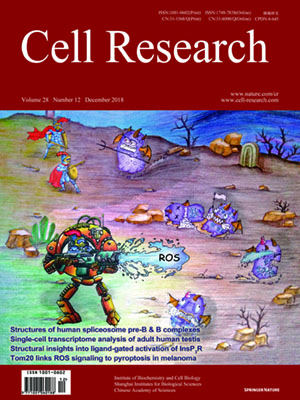
Volume 28, No 12, Dec 2018
ISSN: 1001-0602
EISSN: 1748-7838 2018
impact factor 17.848*
(Clarivate Analytics, 2019)
Volume 28 Issue 12, December 2018: 1141-1157 | Open Access
ORIGINAL ARTICLES
The adult human testis transcriptional cell atlas
Jingtao Guo 1,2, Edward J. Grow 1, Hana Mlcochova 3, Geoffrey J. Maher 3, Cecilia Lindskog 4, Xichen Nie 1, Yixuan Guo 1 ,Jina Yun 5, Long Cai 5, Robin Kim 6, Douglas T. Carrell 2, Anne Goriely 3, James M. Hotaling 2 and Bradley R. Cairns 1
1 Department of Oncological Sciences and Huntsman Cancer Institute, Howard Hughes Medical Institute, University of Utah School of Medicine, Salt Lake City, UT 84112, USA; 2Department of Surgery (Andrology/Urology), Center for Reconstructive Urology and Men’s Health, University of Utah Health Sciences Center, Salt Lake City, UT 84122, USA; 3Radcliffe Department of Medicine, MRC Weatherall Institute of Molecular Medicine, University of Oxford, Oxford OX39DS, UK; 4Department of Immunology, Genetics and Pathology, Science for Life Laboratory, Uppsala University, SE-751 85 Uppsala, Sweden; 5Division of Biology and Biological Engineering, California Institute of Technology, Pasadena, CA 91125, USA and 6Section of Transplantation, Department of Surgery, University of Utah School of Medicine, Salt Lake City, UT 84132, USA
Correspondence: Correspondence: Bradley R. Cairns (brad.cairns@hci.utah.edu)Senior authors: Anne Goriely, James M. Hotaling, Bradley R. Cairns
Human adult spermatogenesis balances spermatogonial stem cell (SSC) self-renewal and differentiation, alongside complex germ cell-niche interactions, to ensure long-term fertility and faithful genome propagation. Here, we performed single-cell RNA sequencing of ~6500 testicular cells from young adults. We found five niche/somatic cell types (Leydig, myoid, Sertoli, endothelial, macrophage), and observed germline-niche interactions and key human-mouse differences. Spermatogenesis, including meiosis, was reconstructed computationally, revealing sequential coding, non-coding, and repeat-element transcriptional signatures. Interestingly, we identified five discrete transcriptional/developmental spermatogonial states, including a novel early SSC state, termed State 0. Epigenetic features and nascent transcription analyses suggested developmental plasticity within spermatogonial States. To understand the origin of State 0, we profiled testicular cells from infants, and identified distinct similarities between adult State 0 and infant SSCs. Overall, our datasets describe key transcriptional and epigenetic signatures of the normal adult human testis, and provide new insights into germ cell developmental transitions and plasticity.
https://doi.org/10.1038/s41422-018-0099-2
FULL TEXT | PDF
Browse 1541


